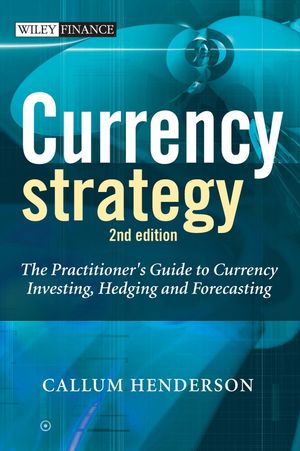Currency Strategy: The Practitioner's Guide to Currency Investing, Hedging and Forecasting, 2nd EditionISBN: 978-0-470-02759-2
Hardcover
264 pages
May 2006
 This is a Print-on-Demand title. It will be printed specifically to fill your order. Please allow an additional 10-15 days delivery time. The book is not returnable.
|
||||||
Acknowledgements.
About the Author.
Introduction.
PART ONE: THEORY AND PRACTICE.
1 Fundamental Analysis: The Strengths and Weaknesses of Traditional Exchange Rate Models.
1.1 Purchasing Power Parity.
1.2 The Monetary Approach.
1.3 The Interest Rate Approach.
1.4 The Balance of Payments Approach.
1.5 The Portfolio Balance Approach.
1.6 Summary.
2 Currency Economics: A More Focused Framework.
2.1 Currencies are Different.
2.2 Currency Economics.
2.3 Summary.
3 Flow: Tracking the Animal Spirits.
3.1 Some Examples of Flow Models.
3.2 Speculative and Non-Speculative Flows.
3.3 Summary.
4 Technical Analysis: The Art of Charting.
4.1 Origins and Basic Concepts.
4.2 The Challenge of Technical Analysis.
4.3 The Art of Charting.
4.4 Schools of (Technical) Thought.
4.5 Technical Analysis and Currency Market Practitioners.
PART TWO: REGIMES AND CRISES.
5 Exchange Rate Regimes: Fixed or Floating?
5.1 An Emerging World.
5.2 A Brief History of Emerging Market Exchange Rates.
5.3 Fixed and Pegged Exchange Rate Regimes.
5.4 Exchange Rate Regime Sustainability – A Bi-Polar World?
5.5 The Realworld Relevance of the Exchange Rate Regime.
5.6 Summary.
6 Model Analysis: Can Currency Crises be Predicted?
6.1 A Model for Pegged Exchange Rates.
6.2 A Model for Freely Floating Exchange Rates.
6.3 Summary.
PART THREE: THE REAL WORLD OF THE CURRENCY MARKET PRACTITIONER.
7 Managing Currency Risk I – The Corporation: Advanced Approaches to Corporate Treasury FX Strategy.
7.1 Currency Risk.
7.2 Types of Currency Risk.
7.3 Managing Currency Risk.
7.4 Measuring Currency Risk – VaR and Beyond.
7.5 Core Principles for Managing Currency Risk.
7.6 Hedging – Management Reluctance and Internal Methods.
7.7 Key Operational Controls for Treasury.
7.8 Tools for Managing Currency Risk.
7.9 Hedging Strategies.
7.10 Optimization.
7.11 Hedging Emerging Market Currency Risk.
7.12 Benchmarks for Currency Risk Management.
7.13 Budget Rates.
7.14 The Corporation and Predicting Exchange Rates.
7.15 Summary.
8 Managing Currency Risk II – The Investor: Currency Exposure within the Investment Decision.
8.1 Investors and Currency Risk.
8.2 Currency Markets are Different.
8.3 To Hedge or not to Hedge – That is the Question!
8.4 Absolute Returns – Risk Reduction.
8.5 Selecting the Currency Hedging Benchmark.
8.6 Relative Returns – Adding Alpha.
8.7 Examples of Active Currency Management Strategies.
8.8 Emerging Markets and Currency Hedging.
8.9 Summary.
9 Managing Currency Risk III – The Speculator: Myths, Realities and How to be a Better Currency Speculator.
9.1 The Speculator – From Benign to Malign.
9.2 Size Matters.
9.3 Myths and Realities.
9.4 The Speculators – Who they are.
9.5 The Speculators – Why They Do It.
9.6 The Speculators – What They Do.
9.7 Currency Speculation – A Guide.
9.8 Summary.
10 Applying the Framework.
10.1 Currency Economics.
10.2 Flow Analysis.
10.3 Technical Analysis.
10.4 Long-Term Valuation.
10.5 The Signal Grid.
10.6 Risk Appetite Indicators.
10.7 Exchange Rate Regimes.
10.8 Currency Crises and Models.
10.9 Managing Currency Risk I – The Corporation.
10.10 Managing Currency Risk II – The Investor.
10.11 Managing Currency Risk III – The Speculator.
10.12 Currency Strategy for Currency Market Practitioners.
10.13 Summary.
11 EmergingWorld: New Growth Markets for Global FX.
11.1 The Growth of Emerging Markets as an Asset Class.
11.2 Increasing Importance of EM Currencies.
11.3 Explosive Growth in Asian Currencies.
11.4 Asian NDF Markets: Growth and Liberalization.
11.5 Emerging European Currencies.
11.6 Latin American Currencies.
11.7 Summary.
Conclusion.
Index.



